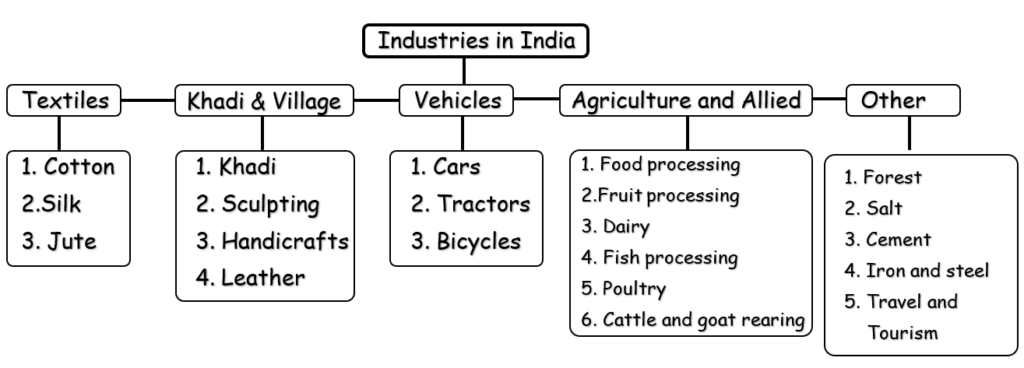1. (A) Choose the right option and rewrite the sentence.
(1) In 1948, Industrial Finance Corporation of India was formed for ……………………..
(a) better development of the industrial sector. (b) making available long term loans to industrial projects. (c) generating employment (d) determining the quality of finished goods.
Ans.
(b) making available long term loans to industrial projects.
(2) …………..……. industry in India is called as the ‘Sunrise Sector’.
(a) Jute (b) Automobile (c) Cement (d) Khadi and village industries
Ans. (b) Automobile
(3) The major responsibility of the textiles committee is ……………………
(a) Production of cloth (b) Determining the quality standards of cloth (c) Export of cloth (d) Generate employment for people
Ans. (b) Determining the quality standards of cloth
(4) ………………… is the major Indian city in the production of bicycles.
(a) Mumbai (b) Ludhiana (c) Cochin (d) Calcutta
Ans. (b) Ludhiana
B. Identify the wrong pair and rewrite the corrected one.
(1) Industrial Finance Corporation of India – makes long term loans available for industrial projects.
(2) Industrial Development Corporation – development of industrial sector.
(3) Textiles Committee – welfare of weavers.
(4) Khadi and Village Industries Commission – promotion of industrialisation in rural areas.
Ans. Wrong pair: Textiles Committee – welfare of weavers.
Corrected one: Textiles Committee Sets the quality standard for textiles.
2. (A) Create a concept picture based on the chapter.
(1) Industries in India.
(2) India’s imports and exports.
Ans. (1) Industries in India.

Ans. (2) India’s imports and exports.

(B) Explain the following concept.
The internal trade of India
Ans.
(1) India’s internal trade takes place through railways, waterways, roads, airways, etc. Ports like Mumbai, Kolkata, Cochin and Chennai are important.
(2) Commodities like coal, cotton, cotton textiles, rice, wheat, raw jute, iron, steel, oilseeds, salt, sugar, etc. are included in internal trade.
(3) Due to the development of industries, the standard of life in the country improves.
(4) Many opportunities for employment become available. On the whole, it helps in the progress of the country.
3. (A) Explain with reasons.
(1) The tourism industry has developed a lot in India.
Ans.
(1) India has a rich cultural heritage. There are places of worship of different religions, pilgrimage centers, confluences of rivers, forts, caves, etc. all over our country.
(2) Tourists from our country as well as from abroad travel in India throughout the year.
(3) The facilities for tourists to stay, travel, etc. are provided through the Tourism Development Corporation.
(4) Sale of curios and the hotel industry thrives in tourist places.
(5) In some places, there are guides who give information to tourists about that area.
(6) Sometimes when vehicles don’t reach the destination in some remote and difficult to reach tourist places, the local people help the tourists in return for a fee.
(7) Employment opportunities are generated out of these needs.
Thus, the tourism industry has developed a lot in India.
(2) The quality of life and standard of living of Indian citizens is increasing.
Ans.
(1) Due to development of trade, commerce and industries, the quality of life and standard of living of Indian citizens have improved tremendously.
(2) More opportunities for employment has become available across various sections of the society.
(3) Thus the quality of life and standard of living of Indian citizens is increasing.
(B) Write answer in 25 to 30 words.
(1) What efforts are made by our government to promote agricultural industries?
Ans.
(1) In order to promote agricultural industries, govt. is giving loans to farmers through rural banks and cooperative institutions, supplying seeds, fertilizers and modern tools for farming.
(2) Farmers are also given training regarding soil testing, dairy farming, poultry, cattle rearing etc.
(2) How is employment generated in the tourism sector?
Ans.
(1) Employment is generated in the tourism sector by involving local people to carter to the needs of tourist.
(2) Local people work as guides and vendors at tourist spots, providing food and transit facilities to the travelers.
(3) Which industries in India are based on forests ?
Ans.
Industries like construction, paper, newsprint, silk, matchboxes, medicinal herbs, honey, lacquer etc. are dependent on forest resources for raw material.
(4) Write a short note on leather industry in India.
Ans.
(1) It is a big industry in India. It is primarily export oriented.
(2) India ranks second in terms of footwear and leather garment production.
(3) Kanpur city in Uttar Pradesh is most famous for it’s fine quality leather.
(4) The Indian leather industry contributes almost 13% of world’s leather production.
4. Complete the table.
Ans.
